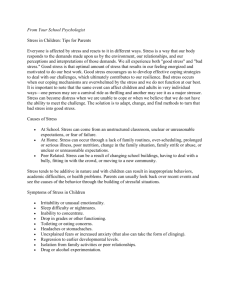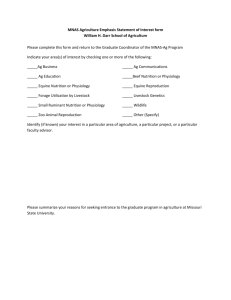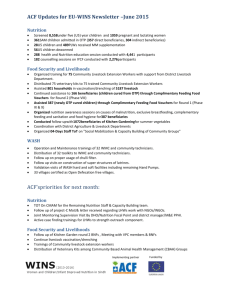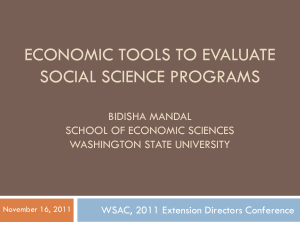PROJECT CONCEPT FORMAT
advertisement
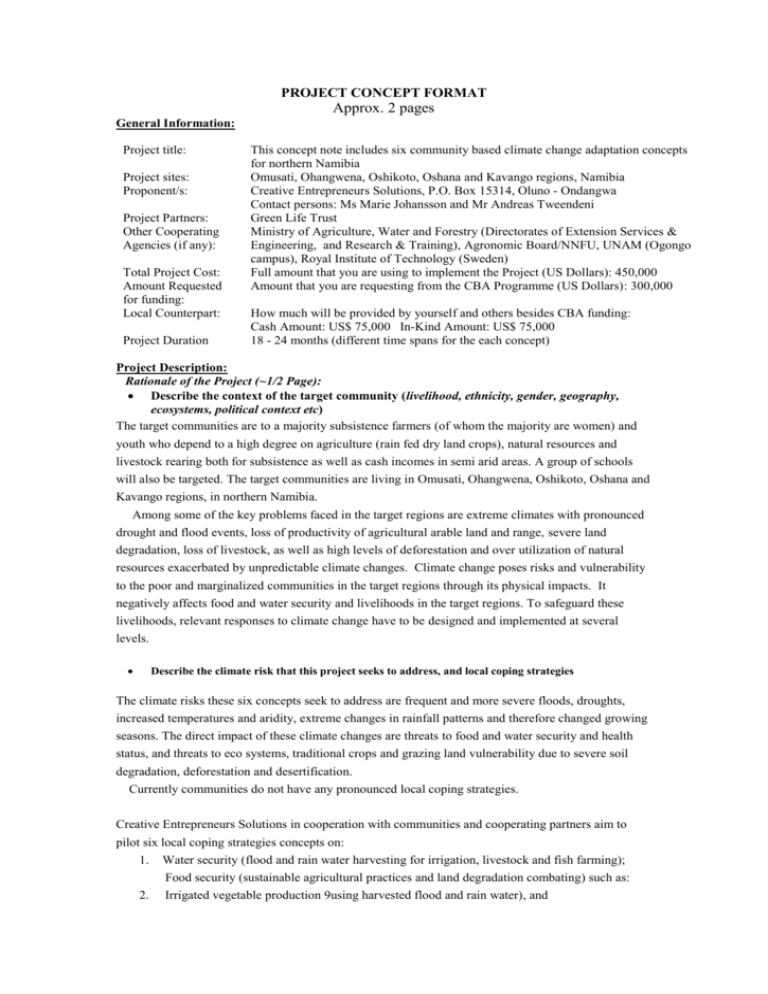
PROJECT CONCEPT FORMAT Approx. 2 pages General Information: Project title: Project sites: Proponent/s: Project Partners: Other Cooperating Agencies (if any): Total Project Cost: Amount Requested for funding: Local Counterpart: Project Duration This concept note includes six community based climate change adaptation concepts for northern Namibia Omusati, Ohangwena, Oshikoto, Oshana and Kavango regions, Namibia Creative Entrepreneurs Solutions, P.O. Box 15314, Oluno - Ondangwa Contact persons: Ms Marie Johansson and Mr Andreas Tweendeni Green Life Trust Ministry of Agriculture, Water and Forestry (Directorates of Extension Services & Engineering, and Research & Training), Agronomic Board/NNFU, UNAM (Ogongo campus), Royal Institute of Technology (Sweden) Full amount that you are using to implement the Project (US Dollars): 450,000 Amount that you are requesting from the CBA Programme (US Dollars): 300,000 How much will be provided by yourself and others besides CBA funding: Cash Amount: US$ 75,000 In-Kind Amount: US$ 75,000 18 - 24 months (different time spans for the each concept) Project Description: Rationale of the Project (~1/2 Page): Describe the context of the target community (livelihood, ethnicity, gender, geography, ecosystems, political context etc) The target communities are to a majority subsistence farmers (of whom the majority are women) and youth who depend to a high degree on agriculture (rain fed dry land crops), natural resources and livestock rearing both for subsistence as well as cash incomes in semi arid areas. A group of schools will also be targeted. The target communities are living in Omusati, Ohangwena, Oshikoto, Oshana and Kavango regions, in northern Namibia. Among some of the key problems faced in the target regions are extreme climates with pronounced drought and flood events, loss of productivity of agricultural arable land and range, severe land degradation, loss of livestock, as well as high levels of deforestation and over utilization of natural resources exacerbated by unpredictable climate changes. Climate change poses risks and vulnerability to the poor and marginalized communities in the target regions through its physical impacts. It negatively affects food and water security and livelihoods in the target regions. To safeguard these livelihoods, relevant responses to climate change have to be designed and implemented at several levels. Describe the climate risk that this project seeks to address, and local coping strategies The climate risks these six concepts seek to address are frequent and more severe floods, droughts, increased temperatures and aridity, extreme changes in rainfall patterns and therefore changed growing seasons. The direct impact of these climate changes are threats to food and water security and health status, and threats to eco systems, traditional crops and grazing land vulnerability due to severe soil degradation, deforestation and desertification. Currently communities do not have any pronounced local coping strategies. Creative Entrepreneurs Solutions in cooperation with communities and cooperating partners aim to pilot six local coping strategies concepts on: 1. Water security (flood and rain water harvesting for irrigation, livestock and fish farming); Food security (sustainable agricultural practices and land degradation combating) such as: 2. Irrigated vegetable production 9using harvested flood and rain water), and 3. Improved dry land crop production through soil improving management strategies such as composting, bio char, crop rotation and conservation agriculture; 4 Flood and drought resistant crops (improved drought resistant mahangu varieties, mushroom, rice and sweet stem sorghum) for human nutrition sources as well as fodder security for livestock/chicken/fish fodder to boos availability of protein nutrition and incomes; 5 Energy efficient stoves and renewable energy in combination with agro forestry/general reforestation and improved natural resource management; 6 Awareness building interventions on climate change, coping strategies, global warming and nutrition needs. 7 Describe the objective of the proposed project, focusing on specific measures to improve adaptive capacity, reduce vulnerability, strengthen ecosystems, improve livelihoods, and empower the community The concepts are interlinked in a chain of coping strategies and objectives that make up a holistic approach: By harvesting flood and rainwater communities will have access to water for irrigated vegetable production, cattle fodder production, fish farming and livestock rearing. By improving degraded soils by using sustainable soil fertilizing as well as water holding capacity techniques such as compost, fertilizer trees, crop rotation and bio char soil fertility and sustainable soil moisture will increase dramatically. By adding the usage of conservation tillage techniques yields are increased and production both diversified as well as becoming an all year round activity. Thus food security is assured. Through applying agro forestry trainings and practices, and the creation of local tree seedling nurseries community members will reforest northern Namibia and thus have access to sustainable wood fuel, highly nutritious fruit and natural oils. By introducing large scale usage of energy efficient wood stoves and renewable energy sources such as solar pumps and bio-gas digesters pollution, the amount of fire wood consumption and deforestation will drop considerably. Agroforestry as well as energy efficient stoves will reduce toxic smoke and greenhouse gas emissions. By introducing new crops such as rice (to be grown in the flooded areas), oyster mushroom (a very protein rich nutrition source) and sweet stem sorghum (grain, sugar, cattle fodder ((silage)) and compost material) not only nutrition levels for children and adults will improve, also livestock, chicken and fish feed will be locally produced to guarantee food security also for animals during floods and droughts. Thus communities and households will significantly decrease over grazing, boost availability of fish and meat locally and increase incomes. The improved and drought resistant varieties of mahangu will help subsistence farmers in producing sustainable staple food under erratic rain conditions and shorter growing seasons. Access to healthy increased protein resources in the form of meat and fish will boost protein nutrition among in particular vulnerable groups such as children and people living with HIV/AIDS. Awareness building interventions on climate change, coping strategies, global warming and nutrition will ensure the social mobilization around these issues, active participation for solutions and also pave way for duplication of strategies by large numbers of communities. The proposed projects with the above objectives will add positively to developing adaptive strategies in response to climate change effects. It will sustainably strengthen household nutrition needs and incomes without further natural resource and land degradation. It will empower communities through reduction in vulnerability and create wealth and self reliance in food and water security. Further, the trainings and awareness raising programs will significantly increase skills and knowledge in sustainable water harvesting, food and fodder security (agriculture), agroforestry and reforestation, nutrition and entrepreneurship (sales of surplus and manufacturing energy efficient stove enterprises). Brief Project Description (1/2-1 page) Briefly state the overall project goal, and list the objectives to be pursued to achieve that goal, and describe the activities to be used to support the objectives The overall project goal is for communities to pilot the above listed concepts to come up with sustainable CBA coping strategies that can be duplicated on large scale locally, nationally and internationally by communities in similar situations. The strategies would also make significant impact on community development, capacity building and poverty reduction. Objective 1: Water harvesting of flood and rain water for water security. Activity: Restoring traditional water wells (rain as well as flood fed) and also introduce underground water harvesting tanks in the traditional water ways as done traditionally in the desert areas of North West India.* Goal: Local annual sustainable water supplies for irrigation purposes, livestock and fish farming. Ease the devastating effects of flooding by restoring traditional waterways reservoirs. Objective: 2 and 3: Agriculture/sustainable land management addressing land degradation for food security. Activity: Irrigated vegetable production from harvested rain and flood water Activity: Dry land crops Activity addressing land degradation: Soil fertility and soil water holding capacity to be increased by subsistence farmers’ use of natural fertilizer (organic material in the form of compost, bio char and fertilizer trees) would lead to soil rehabilitation and sustainable land management. Harvested water would be used for irrigation. Conservation tillage would be applied for water harvesting in furrows and improving soils through zero tillage. By drastically reducing farmers' manipulation of the soil, zero-tillage farming will help conserve water and nutrients for crops and, as an added benefit, reduce the amount of carbon dioxide released from the soil into the atmosphere, where it contributes to climate change. Additional activity: Large scale composting to be tested together with the Green Scheme and small scale farmers so as to ensure that green matter is not wasted in existing vegetable and larger scale farming operations. Goal: Irrigation and improved soils management will lead to a diversification in crops (vegetables) and increased yields in dry land crops. Local food security will be ensured. Duplicated on large scale national food security will increase and national dependency on imported food will drop. Objective 4: Flood and drought resistant crops Activity: Local production of oyster mushroom (rich protein source), rice (to be grown in flooded areas and natural oshanas) and sweet stem sorghum for human nutrition sources as well as fodder security for livestock/chicken/fish. Gains from sweet stem sorghum are multiple: Grain, sugar, stems and leaves that could be stored as silage for livestock fodder in the dry season/droughts, used as compost materials or material for bio-gas digesters. The increased use of improved drought resistant mahangu varieties will ensure staple food security in changing climates. Goal: Food security, boost in local protein sources, decreased vulnerability of livestock to drought. Increased local production of chicken and fish. Objective 5: Energy efficient wood stoves and renewable energy in combination with agro forestry/general reforestation and improved natural resource management. Activity: Energy efficient stoves to be widely used to reduce up to 75% usage of fire wood for cooking food, in combination with agroforestry i.e. the farming and intercropping of (communal as well as on household levels) of fire wood trees, fruit trees, indigenous trees and bushes, and fertilizer trees. Local plant nurseries to be run by communities to ensure the availability of large amounts of tree seedlings. Piloting local bio-gas production through green stover from sweet stem sorghum. All sources needing electric power such as irrigation pumps would be solar powered. Test the potential of distilling bio-ethanol from sweet stem sorghum juice to be obtained from crushing the stems. Goal: Widespread usage of energy efficient wood stoves, bio-gas and solar energy powered pumps to reduce deforestation and green house gas emissions. Large scale community and household agroforestry and general reforestation. Objective 6: Awareness building interventions on climate change, coping strategies, global warming and nutrition. Activity: Social mobilization on community level within target communities and schools. Awareness raising (CBA toolkit) and community members engaged in raising programme focusing on climate change risks and adaptation strategies. CBOs, NGOs, businesses, tradtional and local authrorities participation alongside communities through the local development committees. Exchange of experiences and coping strategies between regions. Exposure trips to each other by communities participating in implementing the six proposed concepts Nutrition and food production awareness raising (with focus on child nutrition, nutrition for people living with HIV/AIDS). Goal: Aware, participating and active general public and key stakeholder groups. Widespread understanding on climate change impact on the environment, natural resources, livelihoods, nutrition, health. Increased health status of children and people living with HIV/AIDS. Sensitized and creative community members that make informed choices. Creating an enabling environment for other communities to duplicate coping strategies to create a holistic and integrated approach to climate change adaptation. Possibilities of turning certain effects of climate change into opportunities. * Included in all concepts are participatory approaches, significant capacity building in the form of community skills development and trainings as well as monitoring and participatory evaluations. Describe the benefits to local communities that the project will achieve Describe how the proposed project will increase the adaptive capacity of the community to climate change including variability through improved natural resources management, or improve the resilience of an ecosystem to climate change including variability Communities will benefit socially and economically by their mobilisation and active participation in improving their livelihood situations and environments. Food and water security will improve, and as a result nutrition and health status will improve. Floods and droughts will have less negative impact. Communities will also benefit ecologically by implementing interventions that lead to ecological sustainability in their local eco systems and reduction in greenhouse gasses emissions. There will be alternative livelihoods created in the form of new foods and products to market and savings on energy costs. Health of the community member’s livestock will increase and chicken and fish farming will be possible for all. Identify the GEF Operation programme that global environmental benefits will be achieved under The GEF focal areas are: the combating of land degradation conservation of biodiversity of national/global importance, climate change mitigation, prevention of persistent organic pollutants (POPs) Indicate real or potential barriers to project success, and actions that will be taken to remove these barriers In order to ensure full participation and create an enabling environment for communities local and regional task teams comprising stake holder groups, CBOs and NGOs will be formed as supporting entities. This will also serve as strengthening of existing institutions/strengthening cooperation to ensure that all support systems available for communities are string and effective. Social mobilization on community level will form an integral part to enable for communities to form strong networks, analyze and understand their situation and create sustainable scenarios. NGO/CBO Background (~1/2 Page) Describe your organization’s mission, history, membership, general activities, and successful experiences Creative Entrepreneurs Solutions (CES) is a Namibian Section 21 Association (NGO, reg no 21/2008/1023) not for gain incorporated in 2008. It is based in Ondangwa. CES focuses on poverty reduction through job and SME creation by women and their families and targets youth through exploring issues of acceleration of equitable agricultural expansion, natural resources and innovative approaches. CES’s philosophy is based on the belief that it is possible to galvanize whole communities through social mobilization, and to create wealth and sustainable food security through social entrepreneurship training and by identifying local resources the population can add value to in an environmentally sustainable way. Our tools and methods are to a large extent based on process oriented ideas research within agriculture (soil improvement techniques for increased yields and crop diversification and so on), renewable energy, natural resource management and to provide services to communities by jointly pilot enterprise ideas with community members, providing training in agriculture, entrepreneurship and social mobilization. Describe community/beneficiary participation in developing this concept paper The concepts have been developed through consultations with communities, CBOs, NGOs and local and regional development committees July – August 2009. The concepts developed in this paper are also based on CES staff and members’ many years of experience of working with communities and national development, piloting concepts, carrying out research and also originating from/living in the target areas. Describe your experience in developing proposals and implementing projects funded by outside donors. If none, describe your organization’s capacities in this regard CES staff and members have as organization and as individuals up to 50 years accumulated experience of community and national development, developing proposals and implementing projects funded by outside donors. Describe the organization’s total budget and sources of funding CES has been granted an operational grant from SIDA and is also creating own incomes. To co-fund the implementation of the CBA concepts CES is also exploring CDM funding. Project Cost What is your best estimate of what the project will cost? What other potential or committed sources of support besides the CBA programme have been identified? Include monetary support, and in-kind support (donated goods, services or labor). Indicate where funds are to be requested from the CBA, and where they are to be requested from other donors. Keep in mind the following: CBA funding can only go to activities that are directly related to safeguarding global environmental benefits in GEF focal areas by increasing ecosystem resilience or improving natural resource management practices in the face of climate change including variability Co-financing is expected from all projects, both cash and in-kind, and will support the generation of global environmental benefits, as well as baseline community development needs The estimated total cost would be USD 450,000 to develop and pilot the six concepts to fully working models that would be ready to be duplicated on large scale/form programs for CBA implementation on national level. Other sources for financing are SIDA and CDM funding through reducing green house gas emissions (energy efficient stoves, reforestation and zero tillage). A large proportion would be financing through in-kind support from implementing partners such as agriculture and forestry extension officers, NGOs, Agronomic Board and so on. Attachments: 1) Sketch/map indicating location of the project. 2) Copy of Charter OR official letter from local government certifying your organization as a legitimate Community-Based Organization if not chartered. Aerial view of north central Namibia. Planning Grant Application: Approved CBA concepts will be issued small planning grants (<$2000) to undertake baseline indicator measurements, and to conduct participatory project planning activities with target communities, fleshing out the loose project architecture described above. The planning grant will also support the development of the full project proposal. The planning phase is expected to take less than 12 weeks, ideally averaging around 6 weeks. Only in exceptional circumstances will grantees be given a four week extension by the NCC. Planning Phase Description (less than 1 page) Describe the activities to be undertaken during the planning phase to collect baseline VRA data and co-design the project with the target community Describe the activities to be undertaken during the planning phase in support of the drafting of the full proposal Describe any outside technical assistance necessary, including any requests for the assistance of the CBA project assistant Extensive consultation with regional development committees (local and traditional authorities), implementing partners, CBOs and NGOs will be carried out to finalize the selection of communities with urgent needs in regard to the proposed concepts. The collection of baseline VRA data and the designing of the concepts implementation strategies and proposals will be undertaken by CES and implementing partners in consultation with selected communities and regional development committees in Omusati, Ohangwena, Oshikoto, Oshana and Kavango regions. Develop an indicative budget for activities to be completed during the planning phase. Note that these funds will be subtracted from the overall grant amount awarded by the CBA. Use the embedded spreadsheet if possible, or alternatively draft a similar table. Please see budget below. Community Partner, implementing partners SIDA Proponent Full amount Cash amount sought required for this from CBA Amount in-kind Amount in-kind Amount cash in item programme in USD in USD USD Budget Item 1 Consultations with regional development committees, partners, CBOs, NGO (6) 2 Consultations with communities 3 Baseline VRA assesments (6) 4 Proposals write ups (6) TOTAL 5,000 3,000 500 500 1,000 7,000 3,000 1,000 1,000 2,000 5,000 3,000 500 500 1,000 5,000 USD 22,000 Total CBA Funding Requested (to be less than $2000 per concept) 3,000 USD 12,000 500 USD 2,500 500 USD 2,500 1,000 USD 5,000 Total Co12,000 Financing 10,000 Table 1: Budget worksheet for the planning phase. If possible use the embedded excel spreadsheet, or alternatively draft a similar table Banking Information Indicate your bank’s name, as well as bank transfer information Bank Windhoek, Ondangwa branch, account name: Creative Entrepreneurs Solutions, account number: 8002216929
